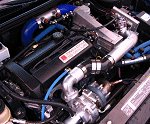

|
Street Class Unlimited Class
DOHC SOHC Ion Updated 1/05 For the most recent list of the fastest five cars click here. |
Turbocharging 101 - Page 2by: qksl2
Something not absolutely proven with Saturns, but
commonly used among turbo Honda owners is a simple AFC or AFR with
larger injectors. An AFC is a fuel computer by Apex, as the AFR
is the same by HKS. Both modify the map signal to the computer so
that you can adjust the injector pulse width at certain RPM points.
I will be experimenting with this in the future, and will determine
how well it works. This is a step up from using a fuel pressure
regulator, as it is more precise. The last option is a full stand alone fuel system.
I personally like the Haltec system. This is a whole different ball
game, and I do not recommend this for anyone who does not want to
really spend some time getting everything dialed in right. You'll
definitely want to have a shop help you with this! 6. Intercooler. I very highly recommend an intercooler with your turbo
setup. It will cool off the intake charge greatly. Cooler intake
charge means more power and more detonation resistance. This is
pivotal with an engine not designed for boost. It allows for a buffer
zone against detonation, and more consistency while running repeatedly.
A great intercooler is the Starion intercooler. These can be found
on ebay commonly for not much money. They utilize the same core
as the Lancer Evolution does, so it flows very well and is efficient.
Other options are the ginormous Twistec intercooler, or a custom
spearco. 7. Intercooler piping. The best piping to use is 2" "hot" and 2.25 inch "cold". The reason for this is the velocity and air density change as it goes through the intercooler. Piping can be sourced from JC Whitney, www.jcwhitney.com. Silicon connectors and clamps can be sourced from www.roadraceengineering.com or www.turbopiping.com. For clams, the screw type works fine, though the T-bolt camps are very nice! 8. A blow off valve is necessary. It relieves pressure in the intake piping created by the spinning turbo between shifts, where the throttle plate closes. It is to prevent damage to the turbo from spinning backwards, known as compressor surge. I like the Turbo XS units, though HKS and Blitz also make very nice ones. These can be commonly found on Ebay or other parts places. The vacuum line reference should go to the intake manifold for an accurate reading. 9. Boost controller. An electronic boost controller is very nice. It allows you to run minimal boost for around town driving, and the bump it up for the occasional street encounter or drag race. However, a manual controller will work. Be careful, though, as manual boost controllers are more prone to boost spiking. As far as which controller, it is mostly preference. I really like my GReddy PRofec A, though the PRofec B is cheaper and simpler, but works well. The ACV-R is quite complex, and has some nice features, but costs quite a bit more. 10. Gauges. Minimum would be boost and a/f gauges. Any boost gauge will work. For an a/f gauge, I like the Halmeter in combination with an o2 sensor from an 89 Escort. It has 3 wires instead of one, so its heated. The Halmeter is a 30led a/f gauge that is available from www.racetep.com. The best solution would be a wideband, but so long as you tune your car on the dyno, the Halmeter is good enough to simply monitor that everything is ok. 11. Oil feed line. It should be a -4 an braided stainless line. Earl's lines are available through Summit Racing. The return line should be a minimum of -8 an, or even -10 an. It should have no kinks, and be downhill all the way. You'll have to have a turbo return line fitting welded into your oil pan. Make sure it is above the level of the oil! |
|



